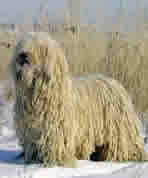
The Komondor, which also goes by the name Komondor Sheepdog and Hungarian
Sheepdog, is one sheepdog indeed. Its coat and color is a flat-out manifestation
of having a dog put on a sheep’s coat. Instead of hair strands and fur,
its white coat is felted and corded with a length reaching 8 to 11 inches (20
to 27 cm). The pup of this breed is born with a fur typical of other heavily
coated breeds but in about 2 years, its outer coat blends with the inner coat
forming cords. These cords take about 5 years to attain desired length. Furthermore,
this dog also has a charming face – almond-shaped and medium-sized eyes,
triangular ears, wide nose, and a long slightly curved hanging tail.
Life Expectancy:
10-12 years
Energy Level:
Average, but adults sleep a lot.
Living Conditions:
Flexible and robust.
Barking:
Higher than average; guard dog.
Exercise Needs:
Daily walk or yard play.
Breed Group:
Working
Size:
Large
Height:
25 - 29 inches
Weight:
80-120 pounds
Standard Hair Colors:
White
National breed club:
Komondor Club of America
The name Komondor is believed to have been derived from Cuman (Komon) people in Hungary who lived near the Yellow River. Komondor would then mean dog of the Komon people. But it is said that this breed actually was brought only to Hungary by the nomadic Magyars and are said to be descendants of the Tibetan dogs. Records referring to this breed were as early as in the 16th century, with herding sheep as its core function. It was only in the 1920s that the Komondor was introduced in dog shows. Today there are Komondor dogs being used to guard livestock.
Though sheep-looking, the Komondor is not sheepish at all. As a responsible and fierce protector of its human family and flock of sheep it herds, it is aggressive towards strangers and potential sheep predator like wolves and bears. However, it is very independent-minded and is best trained by an experienced owner at an early age and socialized with people and other pets. This dog can also easily get bored and may even have the tendency to be lazy and sleep away for hours.
This dog needs plenty of outdoor exercise. A daily 30 minute walk or 30 minutes of yard play.
Apartment life is not the best condition for the Kuvasz. It is an active dog and a large yard will make it happy. Keeping it leashed can also make it destructive. Warm and humid weather conditions are also not ideal for this thickly coated dog. Plenty of water and shade are vital provisions.
The Komondor does not require any brushing because of the “nature” of its coat, being felted and corded.
Like other large breeds, the Komondor is vulnerable to hip dysplasia as well as bloat and skin problems.
...so much for its atypical “get-up”, you may also want to check out the Hungarian Puli (or Puli for short). This breed is smaller, but is as wonderfully corded and felted as the Komondor. What’s more amazing, its coat is not limited to white (white coat for a Puli is considered rare) but can be black, gray, and even apricot.

Copyright © 2005-2016 Pet Information All Rights Reserved
Contact us: www162date@outlook.com